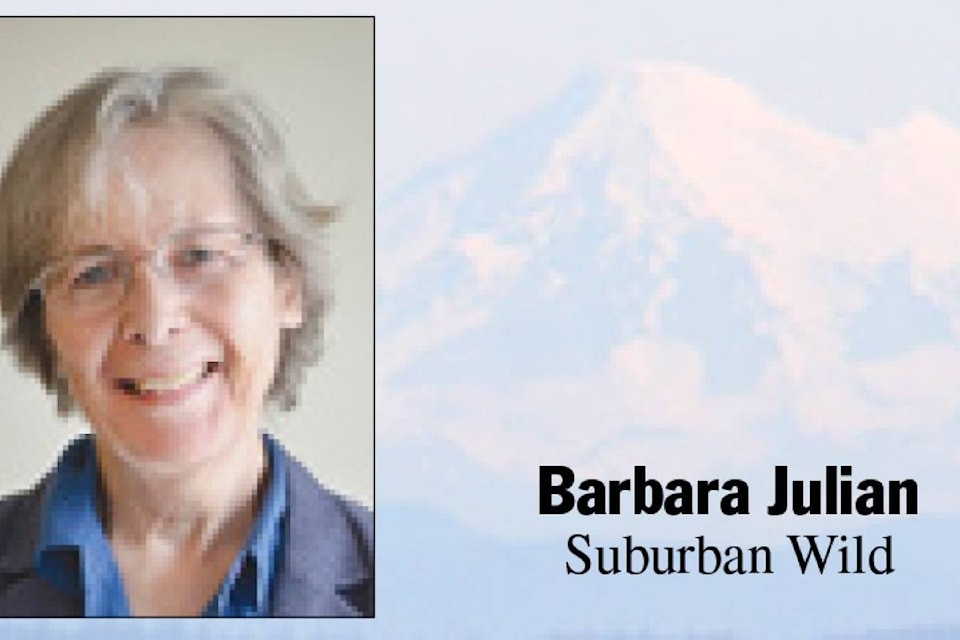It doesn’t get the respect that forests do, but from an ecological point of view grassland is just as important, in both cities and wilderness. The giant trees and wispy grasses of the botanical world work together. It was as grassland that seed-bearing plants first colonized the planet some 450 million years ago, taking over what had been a fern-world (plants that reproduced by spores).
The reproductive cells of grasses are transferred from one plant to another in pollen mostly carried by wind. Oak Bay’s original meadow landscape was created, we might say, by sea breezes. Grazing animals followed of course, and shaped the meadows when different ungulate species ate grasses at different heights, while the stomping action of their hooves caused an evolutionary adaptation in grass: its shoots grow not from the tips of leaves but in a protected position on the soil just above the roots.
Our kind of animal also evolved on grassland (“savannah”) and we still like to replicate our ancestral habitat by surrounding our homes with lawn. A healthy community retains space for grass, which is to say space for open space itself. Grassland is not merely empty real estate. Like natural prairie, cultivated grass is a soft, cushioned surface, rippling in breezes, alive, inviting, a place for play, picnics, croquet, frisbee tossing or (if you’re still a child) rolling down hills. It’s also a carpet of photosynthesis, absorbing carbon dioxide and turning energy (sunlight) into matter (carbohydrates) and emitting the oxygen we breathe.
The fine fibrous roots of grass form a net which holds soil and water in place, as people discover when they remove lawns and then find a dustbowl of dry dirt tracked into their houses. The course grasses of shorelines keep sandy dunes in place which form a buffer between land and sea and modulate wave action, protecting the habitat of intertidal species. Locally we can only imagine them once doing this, since we have over the decades ringed our bays with concrete.
Ecologists use the lovely Gaelic word “machair” for the zone of inland grasses where in Scotland and Ireland farmers graze cattle on turf that sprouts flowers, attracting moths and other meals for birds. So wedded to their habitat are cattle that their chambered stomachs actually change over the seasons as delicate shoots of spring grass change to the tougher, dryer blades of late summer. The cattle on the early Tod and Bowker farms of Oak Bay would have matched physiology and habitat that way, free of the factory-feedlots where cattle today are fed indigestible corn.
For butterflies, crickets, garter-snakes, bees in the clover, grazers and pollinators, mallards, geese, field mice and the raptors that prey on them, raccoons digging insects and robins pulling worms after rain, grass is infrastructure. Where, in Oak Bay, can these creatures still find it? Anderson Hill, Uplands Park and bands of meadow on the fringes of UVIC and the edges of two golf courses are the main places (outside of private gardens).
Other lovely poetic old words associated with grassland are becoming as rare as that landscape itself: sward, feld, spinney, holloway, copse. There’s a spinney of sorts (a clump of trees growing on the spine of a hill) on the ridges of Anderson Hill, where the twisted little oak branches bend down and press on the rock with which they merge their substance: wood and stone, bio-mass and geo-mass blending alongside the holloway that leads down to Transit Avenue. Maybe one day more such once-privately owned areas will be purchased for parkland and snatched from the jaws of bulldozers. The grass-inhabiting wildlife would thank us for it.
Barbara Julien is a local writer and nature enthusiast. She writes monthly about the various species making their home in Oak Bay.
